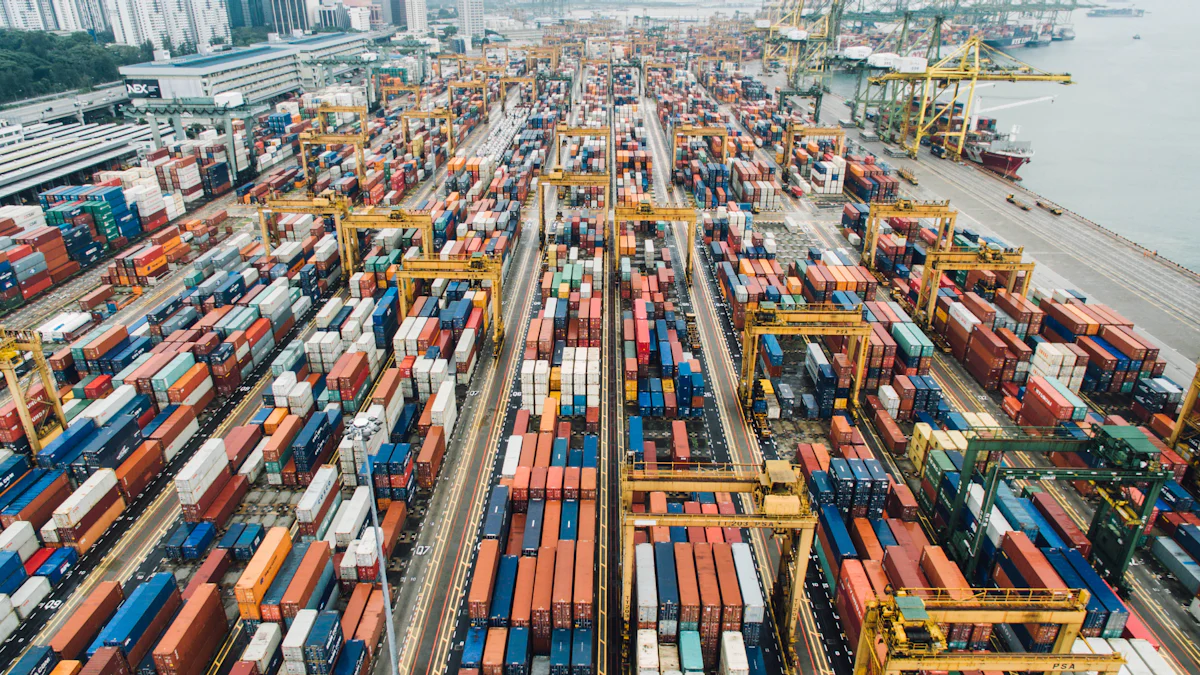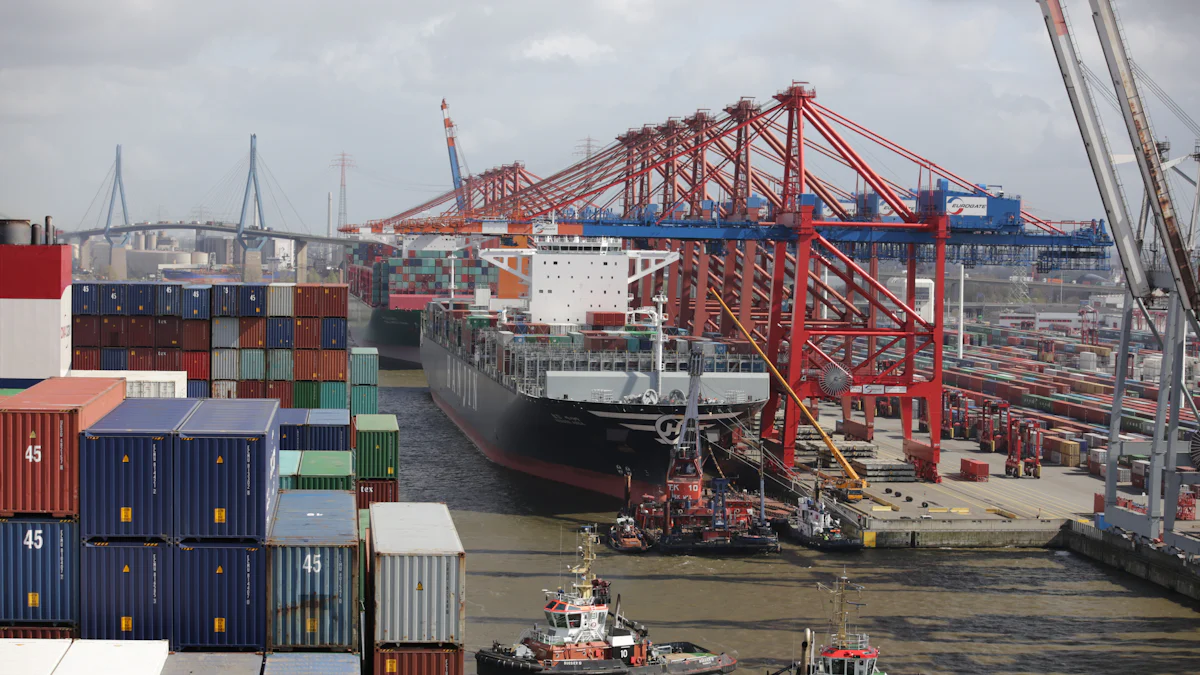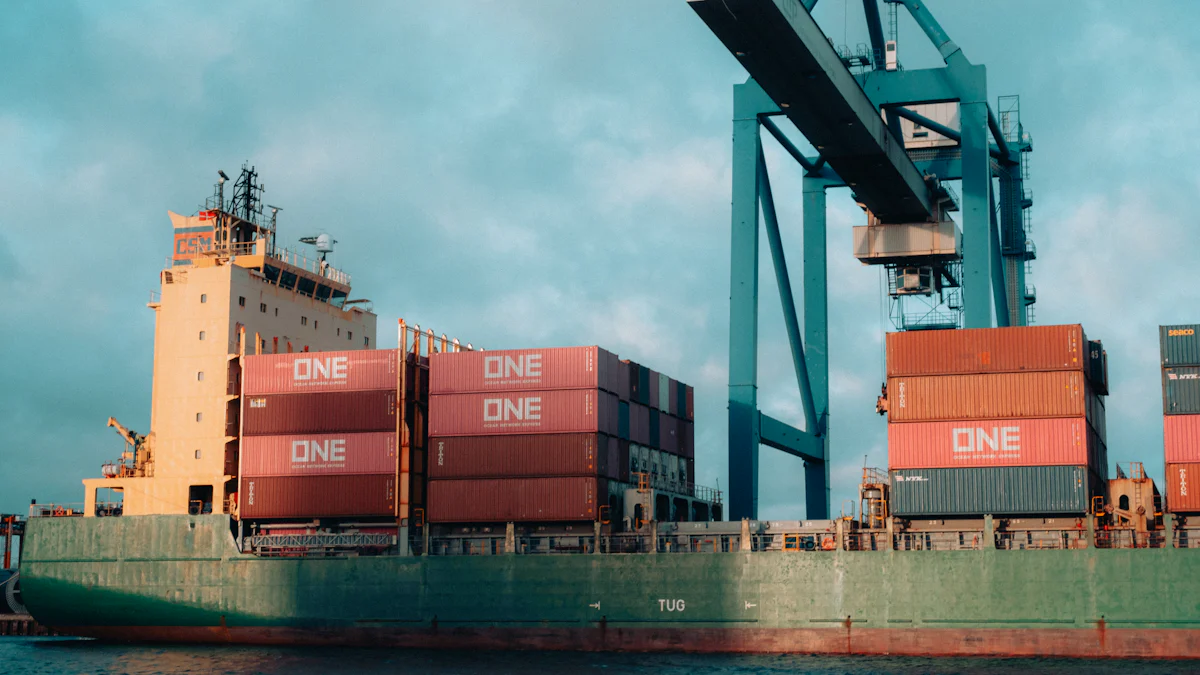Manufacturing’s ongoing supply chain issues for 2025

The manufacturing sector continues to grapple with significant supply chain issues in 2025. Geopolitical tensions have disrupted shipping routes, while labor shortages have caused delays in production and transportation. Over 80% of industry professionals report labor turnover as a major disruption. Material scarcity, compounded by rising shipping rates, has further strained operations. These challenges, reminiscent of vulnerabilities exposed during the COVID-19 pandemic, demand innovative strategies. Manufacturers must prioritize resilience to navigate these persistent disruptions and maintain operational efficiency in an increasingly volatile global market.
Key Takeaways
Problems like global conflicts and fewer workers make things hard for factories in 2025. Companies need smart plans to handle these problems.
Using suppliers from different places helps avoid relying on risky ones. This makes businesses stronger and lowers the chance of running out of materials.
Flexible supply chains help factories adjust quickly when demand changes. Good predictions and live data are important for staying efficient.
High-tech tools like AI and IoT can make work better. These tools help with planning, tracking supplies, and seeing the whole supply chain clearly.
Working closely with suppliers helps create new ideas and stronger systems. Talking openly is important to manage risks well.
Persistent Supply Chain Issues
Geopolitical Tensions
Trade wars and sanctions disrupting global supply chains
Geopolitical tensions continue to create significant disruptions in supply chain operations. Trade wars and sanctions have restricted access to critical markets, forcing manufacturers to seek alternative routes and suppliers. Military conflicts in regions like the Middle East and Ukraine have further exacerbated these challenges. Attacks on ships in the Red Sea have limited traffic through the Suez Canal, a vital trade artery. Additionally, the drought affecting the Panama Canal has caused shipping delays, adding to the strain on global supply chains. These geopolitical challenges demand proactive strategies to mitigate risks and maintain operational continuity.
Regional instability affecting material sourcing
Regional instability has disrupted material sourcing for manufacturers. Ukraine, a major supplier of neon gas essential for semiconductor production, has faced significant challenges due to ongoing conflicts. Similarly, the mobilization of Israeli Defense Forces has left many companies without employees, impacting production timelines. Manufacturers must diversify their supply chains to reduce reliance on unstable regions. By engaging suppliers across multiple locations, companies can enhance resilience and minimize the impact of regional disruptions.
Material Shortages
Scarcity of critical raw materials and components
Material shortages remain a pressing issue for manufacturers. The scarcity of critical raw materials, such as rare earth metals and semiconductors, has led to elevated costs and production delays. These shortages stem from increased demand, supply chain disruptions, and geopolitical tensions. Manufacturers must address these ongoing supply chain challenges by adopting innovative sourcing strategies and building stronger supplier relationships.
Diversifying suppliers to mitigate risks
To combat material shortages, manufacturers are diversifying their supplier base. Companies like Apple have shifted production to regions like India and Vietnam to reduce dependency on single-source suppliers. Restructuring supply bases and engaging multiple suppliers across different locations have proven effective in mitigating risks. This approach not only enhances supply chain visibility but also reduces vulnerability to global disruptions.
Demand Volatility
Fluctuations in consumer demand impacting production
Demand volatility poses a significant challenge for supply chain management. Seasonal trends, economic factors, and external events often lead to unpredictable shifts in consumer demand. For instance, marketing campaigns or regulatory changes can cause sudden spikes or drops in demand, disrupting production schedules. Manufacturers must adopt agile strategies to address these fluctuations effectively.
Agile supply chain management for better adaptability
Agile supply chain management offers a solution to demand volatility. By leveraging accurate demand forecasting and real-time information systems, manufacturers can align supply with demand more effectively. Agile production strategies, such as postponement and modularization, allow companies to adapt quickly to changing market conditions. Continuous monitoring of key performance indicators ensures that supply chain operations remain efficient and responsive to disruptions.
Technological Solutions for Supply Chain Management

Artificial Intelligence (AI)
AI-driven demand forecasting and inventory optimization
Artificial intelligence has revolutionized supply chain management by enabling manufacturers to predict and respond to potential disruptions. AI-driven tools analyze vast datasets to forecast demand accurately, reducing delays caused by stockouts or overstocking. These tools also optimize inventory levels, ensuring that manufacturing operations run smoothly. By 2026, over half of the world's largest manufacturers are expected to use AI to redesign their service supply chains, solving three-quarters of problems before they escalate. This proactive approach enhances operational efficiency and minimizes risks associated with supply chain issues.
Predictive analytics for identifying disruptions
Predictive analytics, powered by artificial intelligence, helps manufacturers identify risks early. These tools monitor factors such as supplier reliability, weather conditions, and geopolitical events to anticipate disruptions. For example, news module intelligence can flag external risks, allowing manufacturers to adjust their operations accordingly. Predictive analytics also improves supplier relationships by identifying reliable partners and addressing potential challenges before they impact production. This data-driven approach enhances supply chain visibility and resilience.
Automation and IoT
Streamlining operations with robotics and IoT
Automation and IoT have become essential in modern manufacturing operations. IoT devices monitor equipment in real-time, boosting productivity by 72% through predictive maintenance and immediate anomaly detection. Robotics streamline repetitive tasks, such as inventory management and shipment tracking, improving operational flow. Real-time tracking enabled by IoT enhances visibility across supply chain operations, allowing manufacturers to make informed decisions quickly. These technologies reduce costs and risks while ensuring smoother production processes.
Automating repetitive tasks to improve efficiency
Automation eliminates inefficiencies by handling repetitive tasks with precision. Smart sensors track inventory levels and automate reorders, preventing stockouts and overstocking. IoT-enabled energy management optimizes energy consumption, reducing operational costs. By 2028, the adoption of robotics and automation in warehouses is expected to increase tenfold, leading to a 30% boost in productivity. These advancements allow manufacturers to focus on strategic initiatives rather than manual processes.
Generative AI and Advanced Tools
Enhancing supply chain planning with generative AI
Generative AI offers transformative solutions for supply chain planning. It models various demand scenarios, streamlining planning processes and minimizing bottlenecks. This technology also optimizes transportation routes, reducing delivery times and costs. By predicting equipment failures, generative AI enables manufacturers to schedule maintenance proactively, avoiding unplanned downtime. These applications improve overall productivity and ensure that supply chain trends align with business goals.
Leveraging advanced data analytics for decision-making
Advanced data analytics empowers manufacturers to make agile decisions. Real-time data enables immediate adjustments, such as rerouting shipments or altering production schedules. Analytics also monitor supplier performance, aiding negotiations and fostering stronger partnerships. By identifying risks like geopolitical instability or supplier financial issues, manufacturers can develop effective contingency plans. This proactive approach mitigates disruptions and strengthens supply chain resilience.
Sustainability and Supply Chain Risk Management

Environmental Regulations
Complying with stricter emissions standards
Governments worldwide are enforcing stricter emissions standards to combat climate change. Manufacturers must adapt their operations to meet these regulations, which often require significant investments in cleaner technologies. For example, transitioning to electric-powered machinery and adopting energy-efficient processes can help reduce emissions. These changes not only ensure compliance but also improve operational efficiency. Companies that fail to meet these standards risk penalties and reputational damage, making proactive compliance essential.
Addressing Scope 3 emissions challenges
Scope 3 emissions, which include indirect emissions from supply chains, present unique challenges for manufacturers. Tracking and reducing these emissions require collaboration across the entire supply chain. Many companies are improving emissions accounting to better understand their carbon footprints. Standardizing Scope 3 data across sectors is critical for establishing clear baselines. Advanced technologies, such as machine learning, enhance emissions tracking and reporting, enabling manufacturers to address these challenges effectively.
Sustainable Practices
Circular economy principles in manufacturing
The circular economy offers a sustainable approach to manufacturing by minimizing waste and maximizing resource use. Key principles include:
Recycle: Breaking down products into raw materials for reuse.
Recover: Extracting materials or energy from non-reusable products.
Eliminating waste: Rethinking resource use at every stage of production.
Keeping materials in use: Encouraging reuse, refurbishment, or responsible recycling.
Regenerating natural systems: Restoring ecosystems and enhancing biodiversity.
Manufacturers can implement these principles by assessing current operations and setting clear goals for circular initiatives. This approach not only reduces environmental impact but also creates long-term value.
Benefits of renewable energy and eco-friendly materials
Adopting renewable energy sources, such as solar and wind, reduces dependency on fossil fuels and lowers operational costs. Eco-friendly materials, like biodegradable plastics and recycled metals, further enhance sustainability. These practices align with consumer preferences for environmentally responsible products, giving manufacturers a competitive edge. Additionally, renewable energy and sustainable materials improve supply chain visibility by fostering transparency in sourcing and production.
ESG Reporting
Importance of transparency in sustainability metrics
Transparency in ESG reporting builds trust among stakeholders. By providing accurate data, manufacturers demonstrate their commitment to responsible practices. Investors increasingly consider ESG factors when evaluating companies, making transparent reporting a critical tool for attracting investment. Clear disclosures also enable meaningful engagement with stakeholders, helping them understand the company’s environmental and social impact.
Tools for effective ESG reporting
Manufacturers have access to various tools to streamline ESG reporting. Platforms like Coolset and Persefoni offer automated solutions for emissions tracking and compliance. Workiva integrates ESG and financial reporting, while Sweep simplifies data collection. Tools such as IBM’s Envizi ESG Suite and AuditBoard centralize ESG data management, ensuring consistency and accuracy. These technologies enhance reporting efficiency and help manufacturers meet regulatory requirements.
Cybersecurity in Supply Chain Risk Management
Cybersecurity Threats
Risks of cyberattacks on supply chain systems
Cyberattacks targeting supply chain systems have surged, posing significant risks to manufacturing operations. Phishing attacks in the industry increased by over 80% between September 2023 and September 2024, while business email compromise incidents rose by 56% year over year. Ransomware attacks affected 83% of manufacturing and utility firms in the past year, disrupting operations and causing financial losses. For example, Toyota halted production at 14 assembly plants in February 2022 after a suspected cyberattack on its supplier, Kojima Industries. These incidents highlight the growing threat of cybercriminals exploiting vulnerabilities in supply chains.
“Attackers are increasingly exploiting these relationships to launch supply chain attacks, targeting weak links to infiltrate OT systems,” Carlos Buenano, CTO for OT at Armis, explains.
Vulnerabilities in IoT and connected devices
The integration of IoT devices into supply chains has introduced new vulnerabilities. Third-party software or hardware components often contain undisclosed flaws, creating opportunities for attackers. This lack of transparency complicates risk management efforts. Data breaches have exposed 97% more records in the past year, and 81% of large businesses reported cybersecurity breaches. These statistics underscore the urgent need to address IoT-related risks in supply chain systems.
Proactive Risk Management
Implementing robust cybersecurity protocols
Effective cybersecurity protocols are essential for mitigating supply chain risks. Best practices include:
Conducting a comprehensive inventory of all assets, including third-party services.
Developing tailored risk management strategies to address vulnerabilities.
Establishing strict access controls to protect sensitive data.
Regularly updating and patching systems to prevent exploitation.
Implementing continuous monitoring systems to detect threats in real time.
Collaboration with suppliers ensures alignment on security measures, enhancing overall resilience.
Regular audits and employee training
Regular audits identify potential security threats and ensure compliance with standards. These audits bolster stakeholder confidence and enhance overall security. Employee training strengthens the human firewall by empowering staff to recognize and prevent cyber threats. Comprehensive programs cover data protection, privacy, and role-based security practices, fostering a culture of vigilance.
Building Resilient Supply Chains
Strategies for mitigating risks and ensuring continuity
Building resilience requires proactive strategies. Reshoring or nearshoring production shortens supply chains, reducing exposure to international disruptions. Manufacturers should prioritize sensitive data by conducting detailed security assessments for high-risk suppliers. Establishing security requirements during initial negotiations ensures alignment from the outset. Frequent assessments and stricter controls for suppliers with a history of breaches further mitigate risks.
Collaboration with partners and suppliers for resilience
Collaboration enhances supply chain resilience by identifying risks and improving responsiveness. Open communication channels enable quicker responses to disruptions, maintaining customer satisfaction. Viewing suppliers as strategic partners fosters innovation, improves product quality, and uncovers cost-saving opportunities. Joint efforts on sustainability initiatives also support eco-friendly supply chain practices, aligning with broader environmental goals.
Manufacturers must prioritize supply chain resilience to navigate the complexities of 2025. Decentralized production models and real-time data sharing enhance adaptability and decision-making. Leveraging AI and IoT technologies optimizes operations, while proactive risk management safeguards against disruptions. Collaboration across the supply chain fosters transparency and strengthens partnerships. Companies like Apple and P&G demonstrate the value of diversification and scenario planning in mitigating risks. By integrating innovation with strategic sourcing and sustainability, the manufacturing sector can address challenges effectively and secure long-term success.
FAQ
What are the main causes of supply chain disruptions in 2025?
Geopolitical tensions, labor shortages, and material scarcity remain the primary causes. Trade wars, regional instability, and rising costs further exacerbate these challenges. Manufacturers face additional pressures from sustainability regulations and cybersecurity threats, which complicate supply chain management.
How can manufacturers address material shortages effectively?
Diversifying suppliers across multiple regions reduces dependency on single sources. Building long-term partnerships with reliable suppliers enhances resilience. Leveraging advanced technologies, such as predictive analytics, helps identify potential shortages early, enabling proactive measures to secure critical materials.
Why is cybersecurity critical for supply chain management?
Cyberattacks on supply chains disrupt operations and cause financial losses. Vulnerabilities in IoT devices and third-party systems increase risks. Implementing robust cybersecurity protocols, conducting regular audits, and training employees strengthen defenses and ensure operational continuity.
What role does AI play in supply chain optimization?
AI improves demand forecasting, inventory management, and disruption prediction. It analyzes large datasets to identify risks and optimize operations. By automating decision-making processes, AI enhances efficiency and reduces delays, enabling manufacturers to adapt quickly to changing market conditions.
How can manufacturers improve sustainability in their supply chains?
Adopting circular economy principles minimizes waste and maximizes resource use. Transitioning to renewable energy and eco-friendly materials reduces environmental impact. Transparent ESG reporting builds trust with stakeholders and aligns operations with global sustainability goals.
See Also
Enhancing Supply Chain Strategies in Advanced Manufacturing Sectors
Key Trends Shaping Supply Chain Efficiency in the Future
Comprehensive Strategies for Manufacturing Success in 2024
Addressing Global Supply Chain Expansion Challenges Effectively
